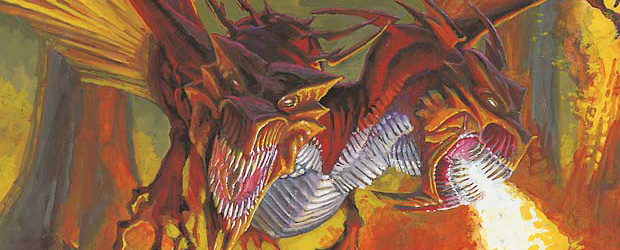
Two-Headed Giant (often abbreviated 2HG or THG) is a multiplayer format in which teams of two people each face each other. This format is unique in the fact that players take actions as a team instead of individually.
Rules
Two-Headed Giant has a few rules that vary from the original rules:
The Two-Headed Giant variant uses the normal rules for winning or losing the game, with the following additions:
Two-Headed Giant has a few rules that vary from the original rules:
- Each team has a shared life total that starts at 30 life.
- Each team takes turns rather than each player. This means that players draw as a team, attack as a team, block as a team, and go through the various phases of the turn as a team. Cards that would make a target player take an extra turn/step or lose a turn/step cause that team to take or lose that turn/step (e.g. Beacon of Tomorrows (create) would make a target team take another turn after this one instead of just one player on that team).
- The team who plays first skips the draw step of their first turn.
- With the exception of life total and poison counters, a team's resource (cards in hand, mana, and so on) are not shared. Teammates may review each other's hands and discuss strategies at any time. Teammates can't manipulate each other's cards or permanents.
- The first mulligan results in a full hand of seven cards (or however many cards constitute a "full hand" if other rules/cards modify the opening hand size). Each mulligan afterward results in one fewer card every time.
- If an effect causes a player to control another player's turn, the controller of that effect controls the affected player's team's turn (e.g. Mindslaver would allow that player to control the entire team's turn instead of one player on that team).
- The legal card format for a DCi sanctioned Two-Headed Giant tournament is the same as the Standard format.
The Two-Headed Giant variant uses the normal rules for winning or losing the game, with the following additions:
- If a team's life total is 0 or less, the team loses the game without receiving priority.
- Players win and lose the game only as a team, not as individuals. If either player on a team loses the game, the team loses the game. If either player on a team wins the game, the entire team wins the game. If an effect would prevent a player from winning the game, that player's team can't win the game. If an effect would prevent a player from losing the game, that player's team can't lose the game.
- If a player concedes, his or her team leaves the game immediately. That team loses the game.
- Poison counters are also shared within a team. If a team has 15 or more poison counters, that team loses the game.
- If a player is unable to draw a card from his or her deck when a situation forces him or her to draw (like at a player's draw step), that player's team loses the game.
- Damage, loss of life, and gaining life happen to each player individually. The result is applied to the team's shared life total. (e.g. If a player plays Flame Rift, each team is dealt a total of 8 damage instead of only 4).
- If an effect needs to know what a player’s life total is, what number do I use?
- If an effect needs to know the value of an individual player’s life total, that effect uses the team’s life total.
- Example: In a Two-Headed Giant game, a team is at 17 life when a player activates Heartless Hidetsugu’s ability, which reads, “Heartless Hidetsugu deals damage to each player equal to half that player’s life total, rounded down.” For the purposes of this ability, each player on that team is considered to be at 17 life. Heartless Hidetsugu deals 8 damage to each of those players, for a total of 16 damage. The team will end up at 1 life.
- Example: In a Two-Headed Giant game, a player controls Test of Endurance, an enchantment that reads, “At the beginning of your upkeep, if you have 50 or more life, you win the game.” If that player's team has 50 or more life when the ability resolves, that team will win the game.
- Example: In a Two-Headed Giant game, a player controls Lurking Jackals, which reads, “When an opponent has 10 life or less, if Lurking Jackals is an enchantment, it becomes a 3/2 Hound creature.” If the opposing team has 10 life or less, Lurking Jackals will become a creature.
- If an effect would set the life total of each player on a team to a number, that team chooses one of its members. On that team, only that player is affected.
- Example: In a Two-Headed Giant game, Ronald plays Biorhythm, which reads, “Each player’s life total becomes the number of creatures he or she controls.” Ronald and his teammate, Edward, are at 13 life. Ronald controls no creatures, and Edward controls three creatures, so their team chooses Edward to be affected by Biorhythm. Edward loses 10 life, and his team ends up at 3.
- If an effect would set a single player’s life total to a number, the player gains or loses the necessary amount of life to end up with the new total. The team's life total is adjusted by the amount of life that player gained or lost.
- Example: In a Two-Headed Giant game, Maureen becomes the target of Magister Sphinx's triggered ability. (Magister Sphinx says “When Magister Sphinx enters the battlefield, target player's life total becomes 10.) Maureen's team's life total is 25 before the ability resolves, so she loses 15 life, and the team ends up at 10 life.

No comments:
Post a Comment